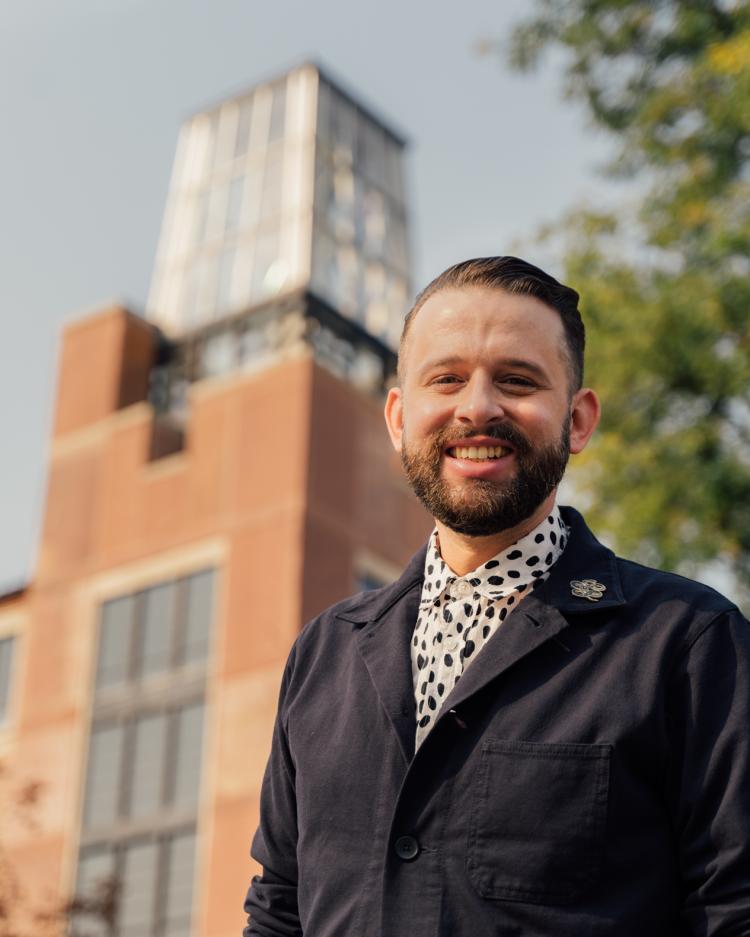Q&A with new B2 director Steven Frost
B2 Reimagined: New B2 director Steven Frost shares the opportunities and difficulties of opening ATLAS Institute’s B2 Center for Media, Arts and Performance during the pandemic and his vision for B2’s future.

Two years later, the center is back online with updated equipment, new leadership, a new name and a new graphic identity. The mission of the B2 Center for Media, Arts and Performance is to support interdisciplinary experimentation and radical creativity that blends art, technology, media, science and performance. In more normal times, B2, as it is casually called, supports a series of artists through the year, who take advantage of the space and equipment to push the boundaries of performance art, performing for small audiences at the end of two-week residencies.
This fall B2’s reduced schedule features two artists, but the team is planning for a more normal program in the spring, albeit with no live performances. These artists will be the first to make use of some of the new equipment, which includes. fifth-order ambisonic speakers, wave field synthesis, 360-video projection, motion capture technology and a Network Device Interface that enables almost instantaneous video transmission over wifi.
In May 2020, ATLAS also named a new faculty director for B2, interdisciplinary artist and media studies instructor Steven Frost, who is supported by a new executive director, Ondine Geary. Geary doubles as the outreach coordinator for the Department of Theatre and Dance. In the interview that follows, Frost discusses his vision for the center and how they are navigating the challenges posed by the pandemic.
As a textile artist, why were you interested in B2’s faculty director position?
I have a master’s degree in fiber and material studies, and I work with textiles, but much of my work is interdisciplinary. In my practice I work with people who do digital fabrication in various makerspaces, and I know how essential collaboration with electrical engineers and other creatives is for artists. Really my art practice is about building community and creating crossovers between technology and traditional art mediums—exactly the kind of collaborations for which ATLAS is known.
What distinguishes B2 from other studios?
B2 provides an opportunity for artists to picture possibilities that they had not previously imagined for their practices by working with our skilled and patient team of technicians and a center with a wealth of connections. Not only do we have many artists inside ATLAS, but the institute is connected to an engineering college, we share a wall with the art museum, film studies shares our building, and the Theatre and Dance Department is just down the street. Our physical location and relationships provide amazing opportunities, and it’s extremely exciting to see that cross-pollination across disciplines and ideas.
What is your vision for the future of the B2 space?
My vision is for writers, dancers and scientists to come into B2 and learn what they can achieve within the space. I’m also interested in bringing people to B2 who are not as comfortable working in technologically advanced spaces, so we can show them the facilities and possibilities and support experimentation. Historically, the development of music and art was led by people willing to experiment with new technologies that fall outside their typical fields, playing with experimental media and finding a new vibe or a new approach. I am really excited to make that opportunity more available to the CU Boulder campus. I also want students to be able to take classes inside B2 that are taught by instructors from across the university, again to encourage interdisciplinary thinking and introduce new ideas to the performing arts.
As an artist, what are you thinking about these days?
When you are trying to create a creative space, subtlety is important, and I often talk about this in my media studies class. With emails, texts and even video, the subtext is difficult to convey. The idea of subtext has become so much harder in this digital world where people kind of say what they mean and you are left wondering where authenticity lives.
How are things going for B2 during the COVID-19 pandemic?
It's been an interesting time for B2 to relaunch. The space is quite active. There aren’t immediate plans for live audiences, but instead we are focusing on student and faculty research inside the space. Ten resident artists will come here this year, including some from the dance and media studies departments. The projects that most of these artists envisioned were pre-COVID, so they have made adjustments and will share their work in other ways, including livestreaming via social media.
Due to the remote format, students have had more time to experiment during the pandemic. The normal two-week residency has not been enough time for some students to complete a live show in. Now, they can make the most of the facilities and create work for digital broadcast or their portfolios using a longer production time frame.
Will the ATLAS Black Box be offering livestream events during the pandemic?
We are finishing our renovations on a three-camera broadcast studio, one of the best facilities to do a livestream, and we will definitely broadcast some events. We’re also interested in exploring live media in the Zoom world; we have the technical ability and the staff expertise for it to look great.
Do you see any lasting benefits of the COVID-related restrictions to B2?
In the creative world, digital media art has been questioned because of its lack of analog tangibility. However, in COVID times it’s taken on more significance and relevance to art instructors in particular. When we come out of COVID, my hope is that digital art will have a more prominent place in creative spaces and that B2 will be in a position to house, nurture and promote it.
Photo by Elliot Whitehead


